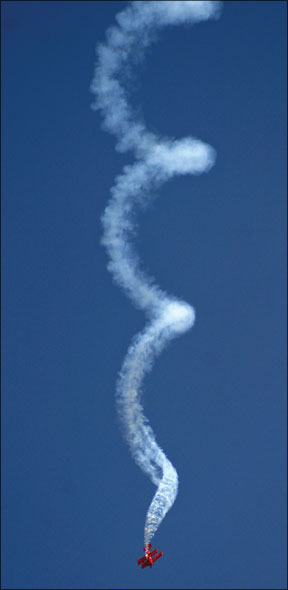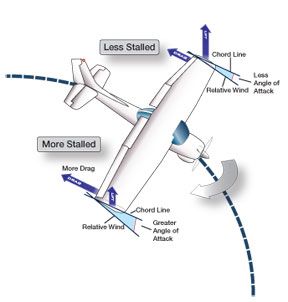The FAA doesnt talk much about spins. Mostly, they want us to learn to avoid them. Clearly, avoiding an inadvertent spin is good, but it might help to know a bit more about them. Plus, the whole specter of Air France 447 crashing into the Atlantic at what French authorities indicate was a very high vertical speed and a nearly level attitude suggests that it might be nice to know a bit about flat spins in particular.
Most of us have heard it before: Spin training used to be mandatory, but sometime
after WWII it was decided most inadvertent stall/spin accidents occurred at an altitude low enough to make recovery unlikely and neednt be taught. So, the FAA dropped spin training from all but the CFI curriculum and instead began to emphasize spin avoidance.
Now, the FAA is taking that one step further by de-emphasizing stall practice and recovery, and instead concentrating on teaching pilots to avoid stalls. With this progression, soon spins and even stalls may be solely the realm of the aerobat and the accident victim. Our goal, of course, is to minimize the latter, so a little education is in order. Well start with a brief discussion of the stall and then focus on the aerodynamics of spins and their recovery. Finally, well take a look at what makes a flat spin.
Stalls 101
During controlled flight, the higher the angle of attack (a), the more lift will be generated. There comes a point, however, at which a is so high the wing can no longer maintain a laminar flow of air. Instead of flowing smoothly along the upper surface of the wing, the air simply continues in the direction of the relative wind. Sometimes called flow separation, this can be visualized by tufting a wing and flying it close to its critical angle of attack.
The tufts will streamline themselves when flow remains attached, but flail around aimlessly and even reverse to fill the low pressure area as a increases. At this point, the wing is stalled and produces very little lift.
Although stalls can occur in any attitude, its easiest to think of them with a horizontal relative wind. When the wing stalls, the nose drops because there is no lift being generated. (At least we hope so: If the center of gravity (CG) is forward of the wings center of lift, the nose will fall through.) This dropping of the nose naturally decreases a and the airflow over the wing will resume its laminar flow.
If youve never performed a “falling leaf” stall, it is something interesting to try. Do a normal straight-ahead power-off stall, but dont recover, just continue to hold full back elevator. Work hard to keep the wings level with the rudders and leave the ailerons neutral. As the wing stalls, the nose drops and the stall diminishes. But, with full up elevator, the wing stalls almost immediately again. Initially, youll likely see a bit of bobbing of the nose, but eventually even that will tend to stabilize. Keep dancing on those rudder pedals to keep the plane from rolling and youll be falling out of the sky in a level attitude. Recovery is simple: Relax up-elevator and add power. While in the stall, though, if you add some crossed controls you could see a wing drop dramatically and begin to enter a spin.
Spins 101
To oversimplify, a spin occurs when youre beginning to stall, but one wing is developing more lift than the other. The result is autorotation about the airplanes CG. This typically happens because there is some yawing motion just as the stall develops. That yaw can result from many factors, but most common is failure to coordinate rudder and ailerons. The result can be mild or dramatic, depending on your “technique” and the airplanes characteristics, but with the spin entry you can expect a significant dropping of the nose and the stalled wing.
After a moment, the planes path is almost straight down and the relative wind is nearly vertical, but the nose is still somewhat above straight down. Of course, its still rotating. The rotation keeps one wings (the one opposite the spins direction, or the outside wing) net effective relative wind greater than the other, keeping the inside wing fully stalled and the other producing some lift. (See sidebar, “Anatomy Of A Spin,” above.)
It takes stall conditions (low airspeed, high a) and rotation to maintain the spin. Therefore, you can correctly predict that either recovering from the stall or stopping the rotation will stop the spin. Proper spin recovery involves both.
Rich Stowell, a noted flight instructor and frequent contributor to this magazine, is credited with creating the acronym PARE for a normal spin recovery-Power-off, Ailerons neutral, Rudder opposite, Elevator forward. Absent any specific technique cited by the manufacturer, reduce power, then smoothly neutralize any aileron input, apply opposite rudder and relax back-pressure to break the stall. This will both stop the rotation and recover from the stall, producing an alarmingly steep dive. Gradually pull back to a level attitude, then bring in power to complete the recovery. Of course this must all be done smoothly and gently, yet without delay. Otherwise, you risk overstressing the airframe by exceeding its airspeed limits, or colliding with terrain if the maneuver began from too low an altitude. Either outcome would be a bad day.
Hows Your Attitude?
A typical spin has both roll and yaw components, while the airplanes center of gravity cork-screws vertically down. The spinning airplanes pitch attitude will be somewhere between level and straight down. If the pitch attitude is almost straight

288
down, the spin is maintained mostly by roll, while if the pitch attitude is nearly level, the spin is maintained primarily by yaw. Thats called a flat spin.
You can prove all this to yourself by simply playing with a model. Try to replicate a spin, using just yaw and roll in various attitudes. Youll see some degree of both is required in all but the horizontal and vertical attitudes. As youd expect, equal amounts of roll and yaw are required if your pitch is 45 degrees down.
If the longitudinal axis of the plane remains aligned with the corkscrew path downward, primarily roll and yaw are present. However, if the longitudinal axis forms an angle with the nose above the corkscrew-think side-slip within the spin-pitching forces are also required to maintain the spin.
Forces At Work
There are some interesting forces at play in a spin. Were all familiar with the normal forces acting on an aircraft: Weight is offset by lift, and drag by power. But a stable spin is different. The vector sum of both lift and drag-the aerodynamic forces-is balanced by the vector sum of the inertial forces of weight and centrifugal force. Youll recall from basic physics that weight is simply a result of a mass in gravity. (If your eyes are starting to glaze over at this point, just remember that in any spin-flat, vertical or in between-lift and drag act together to balance weight and centrifugal force. The attitude required to balance those opposing forces is influenced by the distribution of mass within the airplane. This is important.)
An aircraft with low wing loading and much of its mass in the wings (a trainer, for instance) has those forces in balance with a rather steep attitude in a spin. Conversely, an aircraft with high wing loading and much of its mass in the fuselage (an airliner with tail-mounted engines, for instance) is in balance in a flatter spin attitude. Although the full explanation of this requires at least one chapter in an aerodynamics text, consider this: Remember how your prop governor works? There are two rotating masses on arms that are free to swing out and up. The faster those masses rotate, the more they move up, further from the axis of rotation. Since you can think of an airplane in a spin as two rotating masses-the wing and the fuselage-connected at right angles and free to move around within the rotation about the center of mass, a more complex version of the same thing happens.
From this you can conclude that how you load a specific aircraft can also influence its spin characteristics and attitude. As alluded earlier, its important to pay close attention to maintaining proper balance within the fuselage and between wing-mounted fuel tanks to prevent surprises that could make a spin much more likely in certain situations. For instance, even a slight aft-CG can cause a spin to flatten because there might be insufficient nose-down elevator force.
Finally, note that these rotating masses are also subject to gyroscopic precession-a force applied to the axis of rotation of a gyroscope produces a resulting movement 90 degrees to the applied force. For example, if youre in a perfectly flat spin to the right and you apply down elevator, the result will be a roll to the right.
Flat Spins
In addition to an aft CG, there are a number of other factors that can cause a spin to flatten. For example, someone new to spins might tend to counteract the perceived roll by entering opposite aileron. This usually wont yield the desired results. Instead it tends to raise the inside wing (primarily through aerodynamic forces) and the nose (primarily from gyroscopic precession), resulting in increased yaw and a flatter spin.
Spin attitude in a propeller plane also is influenced by the gyroscopic forces from the spinning propeller. High rpm, a massive propeller and a prop far from the CG all increase the “power” of that gyroscope. Meanwhile, the low effective airspeed in a spin minimizes the aerodynamic forces available to overcome the gyroscope.
Here we get into a situation of cascading forces where, for instance, the clockwise prop produces a left yaw (you know that from your first takeoff), but that yaw, in turn, through the gyroscopic precession of the left-spinning airframe itself causes a pitch up into a flatter spin. In some cases, this flat spin may not be recoverable until power is reduced to cause a steepening of the spin.
Flat spins can be bad because in some cases of wing and fuselage loading and distribution of mass, recovery is impossible through normal means. If you ever find yourself in any spin, the first and normally successful recovery is PARE. However, if youre in some extreme regime or in a flat spin where PARE doesnt work, you may have to try out- or even in-spin aileron. In certain cases, either can break the spin.
SCRATCHING the Surface
As we researched this article, we were surprised at the complexity of factors acting on a “simple” spin. Consequently, in order not to have this article fully consume the entire 2010 schedule for Aviation Safety, weve had to just touch on some of the topics. Our approach to this has been somewhat like skipping a stone across the water. In one simple throw, a lot of distance is traveled and a lot of water is touched, but there is a vast amount of water yet to be explored.
One particularly enlightening reference we found and relied upon heavily in writing this article is Bill Crawfords excellent copyrighted treatise on spins, available online at www.flightlab.com. We recommend it for your further study.
Frank Bowlin is a regular contributor to Aviation Safety, Aviation Consumer and IFR magazines. He was surprised at the flatter spin in the CRJ he flies compared to the C172 he spun during CFI training. After crashing the CRJ, the instructor congratulated him on terrible technique, and they all got out of the sim for a break before trying again.




